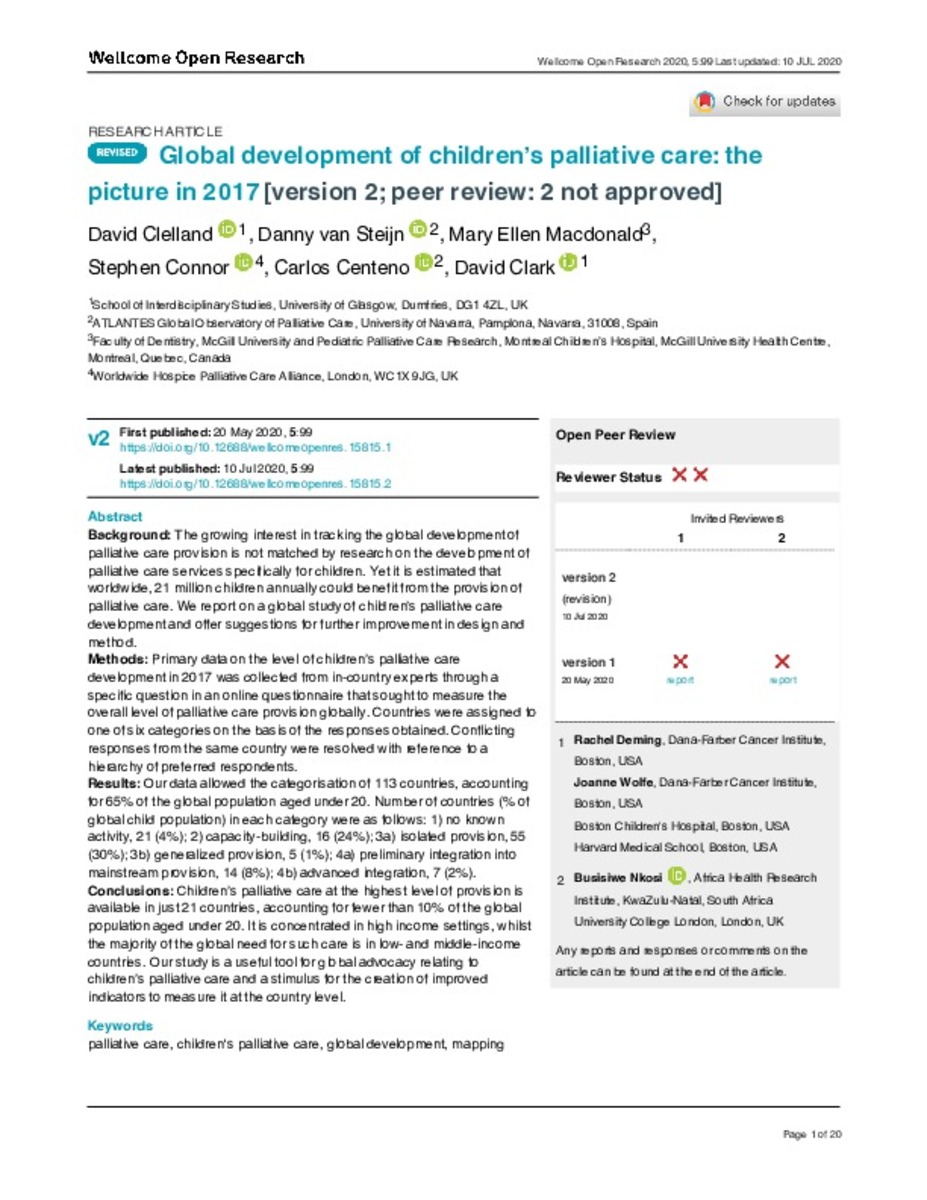Full metadata record
| DC Field | Value | Language |
|---|---|---|
| dc.creator | Clelland, D. (David) | - |
| dc.creator | Steijn, D. (Danny) van | - |
| dc.creator | Macdonald, M.E. (Mary Ellen) | - |
| dc.creator | Connor, S. (Stephen) | - |
| dc.creator | Centeno, C. (Carlos) | - |
| dc.creator | Clark, D. (David) | - |
| dc.date.accessioned | 2020-08-06T10:25:59Z | - |
| dc.date.available | 2020-08-06T10:25:59Z | - |
| dc.date.issued | 2020 | - |
| dc.identifier.citation | Clelland D, van Steijn D, Macdonald ME et al. Global development of children’s palliative care: the picture in 2017. Wellcome Open Research 2020, 5:99 | es_ES |
| dc.identifier.issn | 2398-502X | - |
| dc.identifier.uri | https://hdl.handle.net/10171/59146 | - |
| dc.description.abstract | Background: The growing interest in tracking the global development of palliative care provision is not matched by research on the development of palliative care services specifically for children. Yet it is estimated that worldwide, 21 million children annually could benefit from the provision of palliative care. We report on a global study of children’s palliative care development and offer suggestions for further improvement in design and method. Methods: Primary data on the level of children’s palliative care development in 2017 was collected from in-country experts through a specific question in an online questionnaire that sought to measure the overall level of palliative care provision globally. Countries were assigned to one of six categories on the basis of the responses obtained. Conflicting responses from the same country were resolved with reference to a hierarchy of preferred respondents. Results: Our data allowed the categorisation of 113 countries, accounting for 65% of the global population aged under 20. Number of countries (% of global child population) in each category were as follows: 1) no known activity, 21 (4%); 2) capacity-building, 16 (24%); 3a) isolated provision, 55 (30%); 3b) generalized provision, 5 (1%); 4a) preliminary integration into mainstream provision, 14 (8%); 4b) advanced integration, 7 (2%). Conclusions: Children’s palliative care at the highest level of provision is available in just 21 countries, accounting for fewer than 10% of the global population aged under 20. It is concentrated in high income settings, whilst the majority of the global need for such care is in low- and middle-income countries. Our study is a useful tool for global advocacy relating to children’s palliative care and a stimulus for the creation of improved indicators to measure it at the country level. | es_ES |
| dc.language.iso | eng | es_ES |
| dc.publisher | F1000Research | es_ES |
| dc.rights | info:eu-repo/semantics/openAccess | es_ES |
| dc.subject | Palliative care | es_ES |
| dc.subject | Children's palliative care | es_ES |
| dc.subject | Global development | es_ES |
| dc.subject | Mapping | es_ES |
| dc.title | Global development of children’s palliative care: the picture in 2017 | es_ES |
| dc.type | info:eu-repo/semantics/article | es_ES |
| dc.editorial.note | This is an open access article distributed under the terms of the Creative Commons Attribution License, which permits unrestricted use, distribution, and reproduction in any medium, provided the original work is properly cited. | es_ES |
| dc.identifier.doi | https://doi.org/10.12688/wellcomeopenres.15815.2 | es_ES |
Files in This Item:
Statistics and impact
Items in Dadun are protected by copyright, with all rights reserved, unless otherwise indicated.






